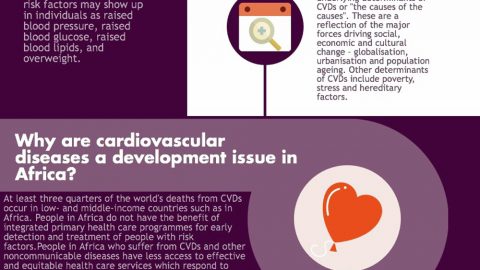Cardiovascular diseases
Cardiovascular diseases (CVDs) are often called "silent killers" because heart attacks and strokes are a common first warning sign of an underlying disease. High blood pressure is the most frequent and most important risk factor for CVDs. Its prevalence is estimated to be about 20 million in Africa.
Isquemic Heart Disease generally refers to conditions that involve narrowed or blocked blood vessels, caused by damage to the heart or blood vessels by atherosclerosis. Fatty plaque buildup that thickens and stiffens artery walls, which can inhibit blood flow through the arteries to the organs and tissues, and can lead to a heart attack, chest pain (angina) or stroke. Other heart conditions, such as those that affect your heart’s muscle, valves or rhythm, also are considered forms of heart disease.
Cardiovascular disease symptoms may be different for men and women and symptoms can include, chest pain (angina), shortness of breath, pain, numbness, weakness or coldness in your legs or arms if the blood vessels in those parts of your body are narrowed, pain in the neck, jaw, throat, upper abdomen or back. Some of the risk factor for developing heart disease may include, age, sex, family history, smoking, unhealthy diet, lack of physical activity, alcohol consumption, hypertension, diabetes and obesity. Many forms of heart disease can be prevented or treated with healthy lifestyle choices.
The most common symptom of coronary artery disease is angina. Angina is often described as a pressure, heaviness, discomfort, aching, burning or a painful feeling in the chest. The symptoms can often be mistaken for indigestion or heartburn.
Behavioural risk factors are responsible for about 80% of coronary heart disease and stroke. The major causes of cardiovascular diseases are tobacco use, physical inactivity, an unhealthy diet and harmful use of alcohol. CVDs occur almost equally between men and women.
Raised blood pressure, raised cholesterol, and overweight and obesity are often outcomes of inadequate lifestyles in the Region. The reduction of salt in the diet, consuming fruits and vegetables, and managing stress are effective ways to reduce the risks of cardiovascular diseases.
Other CVDs include peripheral artery disease, rheumatic heart disease, congenital heart disease and heart failure. Poverty, lack of education, and unplanned urbanization can increase exposure to cardiovascular risk factors.


